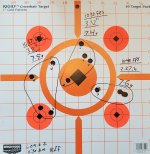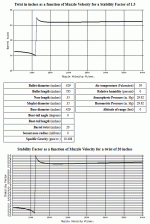CAUTION: The following post (or a page linked to) includes or discusses loading data not covered by currently published sources of tested data for this cartridge (QuickLOAD or Gordon's Reloading Tool data is not professionally tested). USE AT YOUR OWN RISK. Neither the writer, The Firing Line, nor the staff of TFL assumes any liability for any damage or injury resulting from the use of this information.
Had an interesting day at the range, though I would share. based on the target the bullets appear to be unstable.
So I am shooing heavy 44spl loads out of my 44mag Henry big boy 20in barrel. The bullets are cast from a NOE mold, 284g wide flat nose, powder coated and gas checked. I plan to use them for deer this fall and was trying to build a subsonic load. Seeing as this is a some what uncommon load I had some help from some guys here with quick load to generate some data, hence the above warning.
I started out the day with some chronograph testing, 6rnds each. The berm is a little over 6ft tall and 100yds away. I had my rifle zeroed at 25yds. I began testing aiming at the center of the berm. I noticed a bullet skip off the ground around 80yds down range. I though it was a bit odd so I did some quick calculations and figured it should only have around 9in of drop. I began aiming 7/8 of the way up the berm and did not have any more issues.
mixed 44spl brass
CCI large pistol primers
Power Pistol powder, all weighed
NOE mold, 284g, powder coated, gas checked, sized to .430.
6rnds per test group
7.4g, avg 1040, SD 11.25, ES 33
7.5g, avg 1046, SD 4.46, ES 10
7.6g, avg 1058, SD 7.76, ES 21
Then I went to do the accuracy testing at 25yds, 4 roud groups. I had a few sighters, and I could not cover the group with my hand. I tested some of my 200g plinking rounds, they grouped decently well, so I decided to go for it and test the 3 loads. Velocities written on the target were not corrected for distance to chrono and BC. Load data above was corrected, thus the difference in velocities.
In any case several of the rounds did not go in straight. Combining that with my issues during chrono testing I'm pretty sure they are not stabilizing well. the Rifle does have a 1:20 twist, and per bergers bullet stability calculator it may be over stable. Im a bit stumped as to what is going on here. Only thing I can think to to is push the velocity up a bit more, as it seemed to like the 7.6g load and see if they start playing nice.

Had an interesting day at the range, though I would share. based on the target the bullets appear to be unstable.
So I am shooing heavy 44spl loads out of my 44mag Henry big boy 20in barrel. The bullets are cast from a NOE mold, 284g wide flat nose, powder coated and gas checked. I plan to use them for deer this fall and was trying to build a subsonic load. Seeing as this is a some what uncommon load I had some help from some guys here with quick load to generate some data, hence the above warning.
I started out the day with some chronograph testing, 6rnds each. The berm is a little over 6ft tall and 100yds away. I had my rifle zeroed at 25yds. I began testing aiming at the center of the berm. I noticed a bullet skip off the ground around 80yds down range. I though it was a bit odd so I did some quick calculations and figured it should only have around 9in of drop. I began aiming 7/8 of the way up the berm and did not have any more issues.
mixed 44spl brass
CCI large pistol primers
Power Pistol powder, all weighed
NOE mold, 284g, powder coated, gas checked, sized to .430.
6rnds per test group
7.4g, avg 1040, SD 11.25, ES 33
7.5g, avg 1046, SD 4.46, ES 10
7.6g, avg 1058, SD 7.76, ES 21
Then I went to do the accuracy testing at 25yds, 4 roud groups. I had a few sighters, and I could not cover the group with my hand. I tested some of my 200g plinking rounds, they grouped decently well, so I decided to go for it and test the 3 loads. Velocities written on the target were not corrected for distance to chrono and BC. Load data above was corrected, thus the difference in velocities.
In any case several of the rounds did not go in straight. Combining that with my issues during chrono testing I'm pretty sure they are not stabilizing well. the Rifle does have a 1:20 twist, and per bergers bullet stability calculator it may be over stable. Im a bit stumped as to what is going on here. Only thing I can think to to is push the velocity up a bit more, as it seemed to like the 7.6g load and see if they start playing nice.
Attachments
Last edited:


